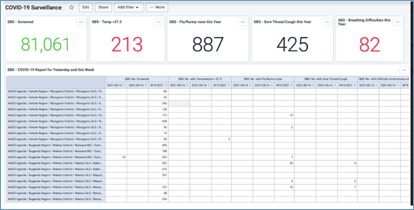The COVID-19 pandemic has greatly affected the education sector in Uganda. The initial lockdown that was instituted in March 2020 saw over 15 million learners kept out of school for over 5 months. Despite government interventions that included distribution of self study materials, online, televised and radio classes, most of the learners especially in the rural areas could not access these learning alternatives. This was due to limited availability of power and internet connectivity as well engagement of learners in domestic work while lessons were being aired. In July 2020, the learning institutions were re-opened in a phased manner starting with the candidate classes. Reopening of schools was tied to the establishment of, and strict adherence to the standard operating procedures (social distancing, mandatory wearing of masks, handwashing) in schools. However, there was a gap on how schools would be able to carry out routine school surveillance, reporting and referral of suspected cases to the nearest facility.
Building on the experience of implementing the DHIS2 electronic Integrated Disease Surveillance and Response (eIDSR) in the health sector, HISP Uganda, Save the Children Uganda in partnership with the Ministries of Health and Education piloted the use of DHIS2 for school-based surveillance in Wakiso and Ntungamo districts. The schools, on a daily basis, were able to screen learners and staff for COVID-19 related signs and symptoms and send aggregated numbers using the short-coded SMS to a toll free 6767 number. A dashboard was created in the DHIS2-DEMIS and accessed by the COVID-19 surveillance teams at district and central level. Suspected cases were then followed up with the school administrators for referral to the nearest facility for further screening and management. In addition, data from schools using an alternate school-based system ‘XULDIME’ was integrated into the DHIS2 for Education and visualized on the school surveillance dashboards. By the end of June 2021, two additional districts of Gulu and Mayuge were include in the pilot had been oriented on school surveillance reporting.

The pilot findings were presented and shared with the different working groups at the Ministry of Health and Ministry of Education and Sports. Since the pilot on DHIS2 for school-based surveillance was limited to only primary schools in four districts, the team was tasked to develop a national scale up plan that will inform scale of DHIS2 school-based surveillance to all learning institutions across the country and further guide re-opening of these institutions starting September 2021.

Sample daily C19 daily reports and SMS report formats